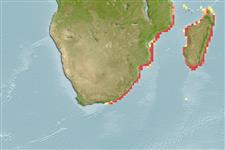>
Eupercaria/misc (Various families in series Eupercaria) >
Gerreidae (Mojarras)
Etymology: Gerres: Latin, gerres = a kind of anchovies; cited by Plinius.
More on author: Regan.
Environment: milieu / climate zone / depth range / distribution range
Ecologia
marino; salmastro benthopelagico. Subtropical; 11°S - 36°S, 24°E - 51°E
Western Indian Ocean: southern Mozambique to Algoa Bay, South Africa; also reported from Madagascar.
Length at first maturity / Size / Peso / Age
Maturity: Lm 14.0 range ? - ? cm
Max length : 30.0 cm TL maschio/sesso non determinato; (Ref. 5213); common length : 20.0 cm TL maschio/sesso non determinato; (Ref. 3409)
Short description
Chiavi di identificazione | Morfologia | Morfometria
Spine dorsali (totale) : 9; Raggi dorsali molli (totale) : 10 - 11; Spine anali: 3; Raggi anali molli: 7. Silvery in color but olive brown above; brown stripes following scale rows above lateral line and the 4 rows below it; spinous dorsal fin with black margins (Ref. 4372). Squamation pattern on the preopercular flange 5-17 scales (Ref. 41102).
Adults inhabit coastal waters including estuaries. They form schools (Ref. 5213). They feed on invertebrates (Ref. 3409). Fry about 10 cm in length enter the estuaries and stay until they reach maturity (Ref. 34363).
Life cycle and mating behavior
Maturities | Riproduzione | Spawnings | Egg(s) | Fecundities | Larve
Woodland, D.J., 1986. Gerreidae. p. 608-609. In M.M. Smith and P.C. Heemstra (eds.) Smiths' sea fishes. Springer-Verlag, Berlin. (Ref. 4372)
IUCN Red List Status (Ref. 130435)
Threat to humans
Harmless
Human uses
Pesca: commerciale
Strumenti
Special reports
Download XML
Fonti Internet
Estimates based on models
Preferred temperature (Ref.
123201): 23.8 - 27.7, mean 26.3 °C (based on 68 cells).
Phylogenetic diversity index (Ref.
82804): PD
50 = 0.5000 [Uniqueness, from 0.5 = low to 2.0 = high].
Bayesian length-weight: a=0.01820 (0.00963 - 0.03438), b=3.05 (2.89 - 3.21), in cm total length, based on LWR estimates for this species & Genus-body shape (Ref.
93245).
Trophic level (Ref.
69278): 3.6 ±0.59 se; based on food items.
Resilienza (Ref.
120179): Alto, tempo minimo di raddoppiamento della popolazione meno di 15 mesi (Preliminary K or Fecundity.).
Fishing Vulnerability (Ref.
59153): Low vulnerability (20 of 100).
Nutrients (Ref.
124155): Calcium = 78.9 [35.9, 162.3] mg/100g; Iron = 0.812 [0.391, 1.642] mg/100g; Protein = 18.6 [16.7, 20.6] %; Omega3 = 0.282 [0.131, 0.554] g/100g; Selenium = 21.5 [10.1, 44.5] μg/100g; VitaminA = 12 [3, 45] μg/100g; Zinc = 0.884 [0.568, 1.404] mg/100g (wet weight);
